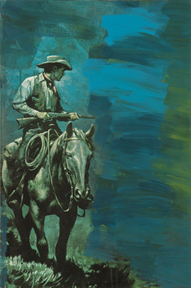Phillips’ Evening Sale to Bring Together Works by
Modern, Post-War, Latin American, American, and Contemporary Masters,
Highlighting the Best of the 20th Century’s Artistic Movements
Basquiat’s The Ring To Lead the Evening Sale on 14 November
Day Sale on 13 November Poised to Break the House Record
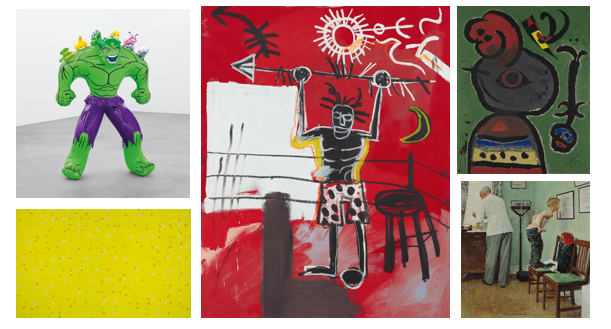
NEW YORK – 29 OCTOBER 2019 – Taking place on 13-14 November, Phillips’ New York auctions of 20th Century and Contemporary Art will encompass works by the past century’s leading artists, spanning a variety of collecting genres. Led by Jean-Michel Basquiat’s The Ring, the Evening Sale on 14 November will offer 42 lots, featuring an extraordinary group of Modern works, alongside lots by Latin American, Post-War, and Contemporary artists, including Andy Warhol, Norman Rockwell, Carmen Herrera, and Philip Guston. Nearly 80% of the lots in the Evening Sale have never before been sold at auction, presenting collectors with the opportunity to acquire these rare-to-market works. The Day Sale on 13 November will be comprised of 346 lots and, estimated to sell in excess of $33.7 million, it is poised to break the auction house’s record for the highest Day Sale total in company history. The sale will include works by Larry Poons, Robert Motherwell, Josef Albers, Yayoi Kusama, Barbara Kruger, Richard Prince, and George Condo, among others.
Robert Manley and Jean-Paul Engelen, Worldwide Co-Heads of 20th Century & Contemporary Art, said, “Phillips’ November auctions of 20th Century & Contemporary Art are a true reflection of the strategy that we have actively pursued in recent seasons. Highlighting the tremendous breadth and scope of the 20th century’s artistic movements, we are proud to present an extraordinary offering of Modern, Post-War, Contemporary, American, and Latin American art by artists who, just a few years ago, would not have been sold in the same sale. On the heels of MoMA’s highly anticipated reopening, the art world is now reevaluating silos that have come to define the art market and we are eager to break down the barriers that have long separated these collecting categories.”
Evening Sale | 14 November
Leading the auction is Basquiat’s The Ring, executed in 1981. Depicting a boxer in a fighting ring, lifting an arrow or spear above his head and crowned with a halo before a crescent moon, the result is a unique marriage between boxing iconography and symbols of African royalty. Perhaps a reference to the boxing magazine of the same name, The Ring situates its Herculean figure within the pantheon of legendary boxers, including Joe Louis and Muhammad Ali, who were particularly influential during Basquiat’s formative years. The artist admired how these men had fearlessly challenged pervasive social and racial prejudices; they had, literally and figuratively, fought their way to fame and success. By depicting these figures victorious, beneath a crown or halo, and accentuating their race with jet black paint, The Ring canonized the African American heroes of his time. Though it is impossible to be certain of the identity of the central figure in The Ring, its similarities to a later self-portrait lead one to believe that the work might portray Basquiat himself. The work would make a fitting self-portrait, as, by the end of 1981, Basquiat had effectively conquered the art world when the watershed essay “The Radiant Child” was published in Artforum.
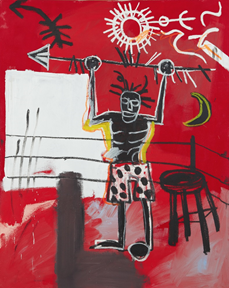
Continuing the sale of works from the predominantly Pop Art collection of Miles and Shirley Fiterman, the Evening Sale will include Andy Warhol’s Late Four-Foot Flowers, a superb example from the artist’s Flowers series. One of only five iterations conceived in this impressive four-foot-square scale, the work is one of the most vibrant Flowers of its size, as it radiates bursts of orange, pink, and mauve. With these iconic relics of postmodernism, Warhol positions himself in the art-historical genealogy of painters of flowers, an age-old aesthetic heritage encompassing both Dutch still-lifes and Monet’s water lilies. Turning his back on tradition, however, Warhol is less interested in portraying a realist or abstract representation of blossoms so much as a modern, mechanical reproduction of a representation of them. Late Four-Foot Flowers is a remarkable example from a Pop genius equally concerned with reinvention as he was with replication.
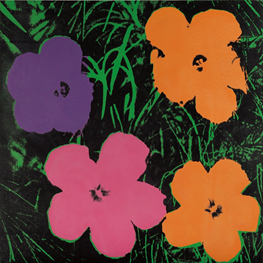
Among the Latin American works to be offered this season is Carmen Herrera’s Amarillo “Uno,” a celebration of harmony and the color yellow as demonstrated through the title of the work. One of the most important works by the artist to come to auction to date, Amarillo “Uno” originates from Herrera’s renowned series of early Estructuras, sculptures based on her paintings which she claimed were “crying out to become sculpture.” This series represents a pivotal moment in the artist’s career, marking the first time she began to transform the geometric abstraction of her paintings into three dimensional sculptures. Soon after initiating the series, the carpenter Herrera hired for the project passed away and the artist was forced to abandon the project, emphasizing the rarity of these early works. This work comes to auction on the heels of the artist’s first outdoor sculpture exhibition which took place at City Hall Park in a show organized by the Public Art Fund this year, featuring later Estructuras comprised of metal.

Hailing from one of Philip Guston’s most celebrated series is Smoking II, a candid self-portrait emblematic of the darkly humorous vulnerability that characterizes work from the artist’s mature period. Painted in shades of pink, scarlet, gray and emerald, and conveying the universal sense of loneliness felt when suffering from insomnia, Smoking II is an intimate portrait of Guston’s own psychological crisis and contemplation of his artistic paralysis. This fleshy and alert figure with Guston’s signature lima bean head—one of the very first he made—lies in bed smoking, staring up at the ceiling. Guston kicked off the series with two paintings, one of which is the present work, which he sold to close associate and fellow artist Grace Hartigan, and the other kept in his own collection until his death. Several of the other works in the series are held in institutions such as the Metropolitan Museum of Art, Stedelijk Museum, and The Museum of Modern Art. Smoking II is a highlight from A Discerning Vision: Property of An Important Private Collection, a collection of nearly one hundred lots to be offered over the course of Fall 2019 and Spring 2020. Eight lots will be offered in the November Evening Sale, including two by Phillip Guston, as well as examples by Sigmar Polke, Robert Ryman, and Vija Celmins.
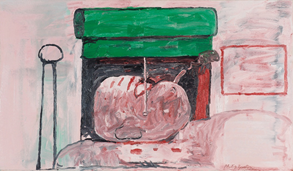
Executed in Yoshitomo Nara’s signature style, Little Thinker features an ambiguously gendered child whose eyes are closed in a state of reflection. This theme of meditative and reflective introspection is one of Nara’s most enduring subjects. A frequent pictorial trope of Nara’s, his innocent and youthful protagonists take on the burdens of an older generation, either holding weapons and swearing or, like Little Thinker, engaged in silent meditation. The work draws from Nara’s long list of influences, from Buddhist inner stillness, Japanese popular culture, anime and manga to Renaissance painting and literature then on to graffiti and punk music. Painted at a pivotal moment in the Nara’s career when he returned to Japan in 2000 after 12 years abroad, Little Thinker epitomizes a crucial shift in the artist’s oeuvre that still informs the painter’s work today.

Previously announced highlights from the season include works from the Collection of Florence Knoll Bassett, with Morris Louis’ Singing and Rufino Tamayo’s Cinco Rebanadas de Sandía being offered in the Evening Sale. One of the most influential architects and designers of Post-War America, Ms. Knoll Bassett’s enduring legacy can still be felt today, over six decades after she became president of Knoll, Inc. Comprised of nearly fifty lots in total that are being sold throughout the fall, the collection offered at Phillips includes works of art and design that this visionary of the 20th century chose to surround herself with over the course of her lifetime. Please click here for the full press release on the collection.
A strong selection of Modern works will also be included in the Evening Sale, with Joan Miró’s Paysan catalan inquiet par le passage d'un vol d'oiseaux leading the group. Unseen for over six decades, the painting was first and last seen in 1953 when shown as a highlight in the artist’s major post-war survey exhibitions at Pierre Matisse Gallery and Galerie Maeght, which served to present his recent work to an international audience. The painting was acquired at the conclusion of the Pierre Matisse show in 1953 and has been held in the same family collection ever since. Also included in the Evening Sale are Pablo Picasso’s Femme assise dans un fauteuil, Alberto Giacometti’s Portrait of G. David Thompson, and Henry Moore’s Family Group. More information on these works can be found here.
For the first time ever, Phillips is proud to include a painting by Norman Rockwell in one of its auctions. Equally of note is that this is the first time any auction house has included a work by Rockwell in an Evening Sale of 20th Century & Contemporary Art. This sale marks the first time that Before the Shot has been offered publicly. Since its execution in 1958, it has remained in two families’ private collections, Rockwell’s own doctor – the model for the image – being the first. The current owners had generously loaned the work to the Norman Rockwell Museum, where it has been on display for the past 13 years. More information on Before the Shot can be found here.
Day Sale | 13 November
Leading the Morning Session of the Day Sale is Robert Motherwell’s Open No. 116: La France Open. Resplendent in color and gesture, the work envelops the viewer in an atmospheric blue field of color anchored by a luminous white window-like form outlined in bold black lines. Completed between 1983 and 1985, this work is the impressive result of over a decade and a half of constant re-working of the canvas. Motherwell began painting the work in 1969, initially conceived it as Open No. 116: In Sienna, Blue and Green, but over the years repeatedly revised the canvas until achieving its current, final state. Exemplary of Motherwell’s characteristic process of revision, this painting hence simultaneously exhibits elements of his early Opens, as well as the looser, more gestural style that Motherwell pursued in the last decade of his life in the 1980s.
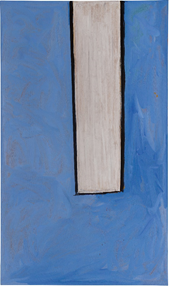
A cardinal symbol of Pop art, LOVE (Blue Outside Red Inside) hails from the collection of Miles and Shirley Fiterman. It is a quintessential example of Robert Indiana’s ability to use text and language to transcend conventional distinctions between Minimalism, Pop art, and modernism. The work has achieved global recognition since its conception in 1966, and versions of the work have been installed in public and private collections across the United States as well as in Canada, Europe, South America, Asia, and Israel. Ascribed to the sculpture’s vibrant palette and instantaneous impact, the work has become an iconic Pop motif that takes its place in the pantheon of imagery alongside Andy Warhol’s soup cans and Roy Lichtenstein’s Ben-Day dots. LOVE (Blue Outside Red Inside) crystallizes many of the major themes that Robert Indiana has investigated throughout his career and one of the most fascinating aspects of this work is its ability to remain timeless and contemporary at the same time. More than 50 years has passed since it’s conception and it is clear that Indiana’s LOVE persists in a profound manner.

Larry Poons’ monumental Jessica’s Hartford, 1965, is a seminal example of the iconic Dots paintings that catapulted the artist to fame in the mid-1960s. Drawing the viewer into a pulsating field of expansive color and light, Poons expands upon the rigorous play of color and optic sensations first explored a few years earlier. The subtle contrasts in color result in a remarkable flickering effect that seems to re-invent the conceptual tenets of Pointillism for the modern age. Distinguished by its exceptional provenance, this work was acquired shortly after its execution by the esteemed art collectors and philanthropists Robert and Beatrice Mayer, co-founders of the Museum of Contemporary Art in Chicago. Poons created his Dots paintings only for a short period between 1963 and 1967, before steering his practice towards gestural abstraction, making Jessica’s Hartford an important early painting within Poons’ oeuvre that beautifully captures light, rhythm and color in a manner that seems to expand beyond the confines of the canvas. The market for Poons’ work has reached new heights in recent seasons, following the artist’s inclusion in the 2018 documentary The Price of Everything.
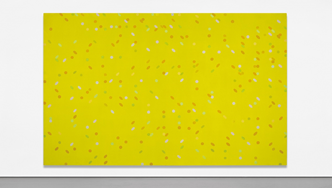
A paradigm of George Condo’s insatiable engagement with the tradition of portraiture, The Picture Gallery illustrates the very theme that has captured the artist for nearly four decades. The Picture Gallery is a captivating example of Condo’s career-long engagement with the female figure—here, as muse, mother, and at times, monster. A testament to its significance within his celebrated oeuvre, the present work was selected as a cornerstone of the artist’s seminal traveling exhibition, George Condo: One Hundred Women, which began at the Museum der Moderne Salzburg in 2005 and then traveled to Kunsthalle Bielefeld. Drawing upon art historical themes such as portraiture, landscape painting, and the iconic subject of mother and child, The Picture Gallery is acutely conscious of tradition, yet simultaneously infused with a contemporary, psychological flare that is quintessential of the artist's signature style. The Picture Gallery is one of 45 works from A Discerning Vision: Property of An Important Private Collection to be included in the November Day Sale.
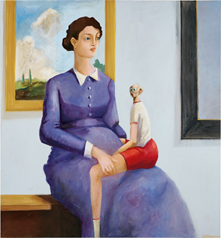
Also among the highlights of the Afternoon Session is Richard Prince’s Untitled (Cowboy). Beginning in the early 1980s, Richard Prince’s depiction of the American cowboy has been one of the most celebrated motifs throughout his long career, arguably the crux of his oeuvre. Originally borrowed from Marlboro advertisements, Prince’s cowboys are both innovative and controversial, presenting thought-provoking questions of artistic authorship and highlighting the effects of marketing on consumers. He reinvigorated the series in the 2010s, executing the current example in 2012, by utilizing old paperback books instead of magazine advertisements as his source imagery. Prince removes any contextual evidence of the image belonging to anything besides his own painting. Remaining as the central and singular subject, the cowboy in the present work is paused for a moment. The wanderer recalls a nostalgia for the past, synonymous with idealistic heroism that is most readily associated with Manifest Destiny and the American Dream.
